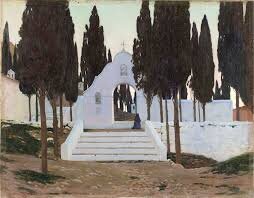Sorolla, After the Bath
Sorolla is always inspiring to me, with all his bravoura and mastery of every key of painting. Maybe not the most contemporary painter you might say, but studying a master as him goes far in helping a student as me. Just look at all the natural and reflected light here—isn’t it gorgeous?
He and his generation of Spanish painters are not the most top of mind either, something which always intrigued me. And maybe that is because art critics of the 20th c put them on the wayside, instead applauding the avant garde, the abstract. Duchamp and company were heralded in, and Sorolla and company a bit forgotten. He had stuck to his guns, championing a naturalistic, color-filled style that was his hallmark. But he was also sandwiched between greats like Goya and Picasso. They, and the troubled times of the fallen Spanish Empire, cast a shadow over artists like Sorolla.
And he was not the only turn-of-the-century artist forgotten. Who has heard of Rusinol Prats, Casas y Carbo, Nunell, Anglada Camarasa? Many of you, but not me until recently. They were all part of the Barcelona avant garde, hanging out in the iconic tavern Père Rameu, championing the renewal of Spanish culture. And they spent lots of time in Paris, the center of modern art, imbibed in the cultural scene there, friends with the artistic leaders. What’s especially appealing is that these artists were all inspired by the French but maintained their own Hispanidad.
Rusinol Prats, Calvario at Sajunto
I especially love Rusinol Prats and Casas y Carbo, who were like blood brothers, inseparable, and leaders of the Père Rameu scene. Rusinol’s landscapes are either moody, as in « Calvario at Sajunto », with the cypresses representing as he said tombstones of the poor. Or they would be glorious, redundant with color, as in « Valle de los Naranjos ». The magnificent warm light of Catalonia bathes the scene, a similar light to that of Sorolla.
Casas y Carbo, Le Moulin de la Galette
Casas y Carbo, La Sagartain
Casas y Carbo’s portraits are particularly modern to me, with « Le Moulin de la Galette » depicting a woman enjoying some of the vices usually reserved to men. Ah, that mysterious gaze. And « La Sagartain », his mistress enveloped in that resplendent yellow with an altogether different gaze. Not a woman to be toyed with.
I first discovered these artists at the Orangerie in 2012, an exhibition called « L’Espagne Entre Deux Siècles Zuloaga à Picasso ». The piece on the cover by Anglada Camarasas is in itself a showstopper. Avant garde with a little bit of Klimt?
https://www.boutiquesdemusees.fr/en/exhibition-catalogues/exhibition-catalogue-lespagne-entre-deux-siecles-de-zuloaga-a-picasso/2882.html





